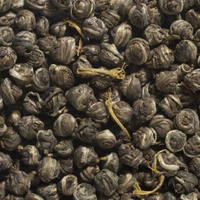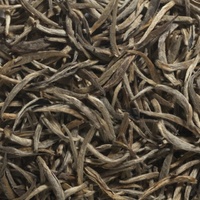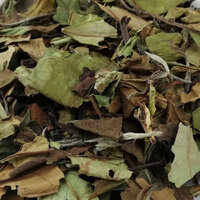White Tea
Image: White tea infusion with chamomile flower scent
White teas are delicate and much-prized teas, made from young, unopened tea buds that are hand-plucked and withered to remove some moisture, then gently dried. The curled buds have a silvery-white appearance.
Originally grown only in the Fujian mountains, white teas are now manufactured in other major tea-producing countries such as India, Kenya, Malawi, and Sri Lanka.
The liquor is pale like Champagne. The flavor is soft and smooth, often with a hint of peach pit and the lingering sweetness of honey.
According to the different standards of picking and manufacturing, most white teas can be classified as either Yin Zhen (only bud) or Pai Mu Tan (two leaves and a bud).
The growing popularity of white tea and the acknowledgement of its apparent health benefits have led to a proliferation of ready-to-drink white-tea beverages. A good selection might include,
Silver Needle (Yin Zhen) is a classic Chinese white tea; consists only of stout buds covered with silvery hairs. The liquor is low in caffeine but high in healthy polyphenols. Silver Needle teas are very expensive but can be infused several times.
Pai Mu Tan (or Bai Mu Dan) also known as White Peony, is more abundant and is a less-expensive form of white tea. For this variation, the top two very young leaves are gently plucked along with the unopened bud. The pickings are sun-dried to keep the tea in its purest form. The lightly oxidized tea produces a very pale liquor. Many American tea purveyors blend this tea with fruit flavours.
Darjeeling White Tea First produced in 2000 and available in limited quantities from several estates, these young spring teas resemble the Chinese White Peony, but the taste is a bit deeper and nuttier than that of the Chinese productions.
What are some white tea benefits?
White tea has several health benefits. It's rich in antioxidants, in particular, a type of polyphenol called catechins. Polyphenols are plant-based molecules that behave as antioxidants in the body. Antioxidants are beneficial because they protect the body from cell damage caused by free radicals. Green tea also has similar antioxidant benefits.
White tea, including organic white tea, is also strongly linked in several studies to a reduced risk of heart disease. One found that polyphenols may prevent LDL cholesterol from becoming oxidized, which is one risk factor for developing heart disease.
For example, in an analysis of five studies, scientists found that people who drank three cups of tea or more per day had a 21% lower risk of developing heart disease.
Other potential benefits of white tea consumption include:
- Possible cancer-fighting compounds
- Can help you lose weight thanks to a possible boost in metabolism
- May lower the risk of insulin resistance
- May help combat skin aging as a result of UV exposure
- May help protect against Parkinson's and Alzheimer's diseases, as indicated in this study
When is the best time to drink white tea?
Many people say that the best time to drink white tea is in the morning and after every meal to help boost your metabolism and aid in digestion. Three cups per day is ideal, but be careful not to consume it right before bedtime, as it does contain caffeine.
Does white tea give you energy?
Some people may feel more energetic drinking white tea from Australia because of the boost to metabolism that it provides — perhaps up to a 4-5% increase, which is equal to burning about 70-100 extra calories a day.
White tea also contains caffeine, which might help you feel more energetic when you drink it.
Is white tea good for the kidneys?
Tea has been frequently linked to the formation of kidney stones, primarily due to its high oxalate content. However, the highest oxalate levels are found in black tea, and white tea has very low oxalate levels. So, while white tea may not be beneficial for kidney health, it is far less harmful in contributing to the formation of kidney stones compared to black tea.
What goes well with white tea?
Pairing tea with food is always an adventure — find the right combination, and the taste of both the food and beverage is enhanced.
White tea and organic white tea boast a subtle flavour, sometimes with hints of peach or honey, so if you drink it with intensely strong foods, you may miss its subtly sweet undertones. Instead, opt for lighter fare, such as plain salads with minimal or no dressing, cucumber-based salads or light seafood dishes.
Otherwise, white tea may be best enjoyed on its own between meals.
What type of tea is white tea?
White tea is made from the leaves of young, unopened tea buds and is considered to be one of the least processed teas on the market. It is considered a true tea, which means it's derived from the Camellia sinensis plant along with black tea, oolong and green tea.
White tea is different from herbal teas, which are not considered true teas since they're not derived from the same plant. Herbal teas are derived from a variety of other plants, including fruits, herbs, spices and flowers.
Sometimes when you shop for white tea in Australia, you may come across some white tea blends — these may include white tea leaves mixed with other herbs, fruits or tea types, such as white Earl Grey tea or white peachberry tea. Although not purely white tea, they may offer some of the same benefits that standalone white tea offers.




